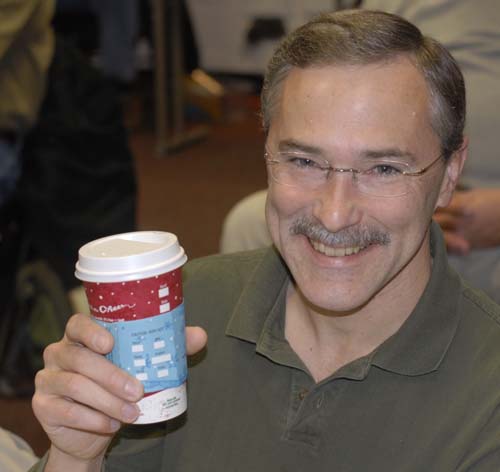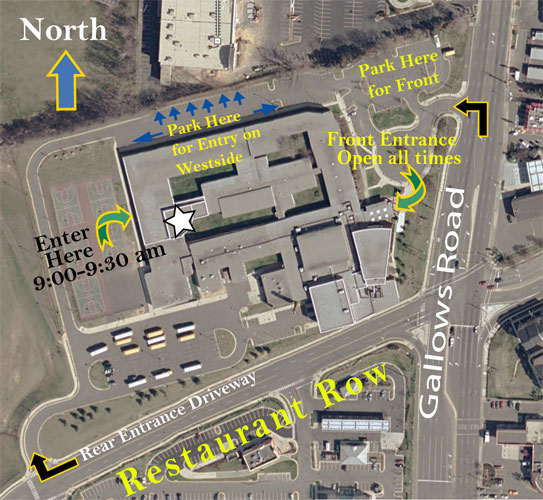



Mac users are cat lovers, as evidenced by the long line of big cats that have graced their computers: Cheetah (Mac OS X 10.0), Puma (10.1), Jaguar (10.2), Panther (10.3), and Tiger (10.4). After a brief appearance at the October meeting (held the day after its introduction), Leopard (Mac OS X 10.5) leapt onto center stage at the November 17 General Meeting, strutting around during a string of short presentations on new and interesting features. At least 90 people were in the audience, prompting a minor flurry as more chairs were set up.
The opening Question and Answer session covered a number of topics, but many of them came back to the same question: should, could, must machines be upgraded to Leopard? Based on three weeks’ experience, the answer is: if your machine is Leopard compatible, you probably will want to upgrade.
Several questions involved E-mail, and why some attachments, messages, formatting and intriguing smells can’t be understood on Windows machines. Moderator Lawrence Charters follows a conservative approach: since the standards for electronic mail are (in Internet years) quite old, and since electronic mail is defined officially as text, send – text. Don’t send formatted text, don’t send HTML, send text. Everyone, on any computer, can read text messages. When you get fancy and use special fonts, colors, background patterns, and embed photographs, you increase greatly the chance that your message can’t be read. If you must send a photo, for example, send one per message. One per message probably won’t cause problems, but multiple photos per message are bound to cause some recipient grief. (See E-mail: Keep It Simple,” http://www.wap.org/journal/emailrules/).
Several people mentioned having difficulties reaching government Web sites with Safari, mentioning in particular the Medicare Web site. Lawrence pushed a hard line in such cases: your tax dollars built these sites, and the sites should be open to all browsers. On a practical level, until the government sees the error of its way, use Firefox or Camino as alternatives to Safari. One audience member suggested Netscape, but Lawrence scoffed at the idea; Netscape has been abandoned by the Mozilla project, and is currently useful only for reading AOL mail and providing AOL advertising. Mac users should use Safari, Firefox, and Camino.
Another question involved transferring music files via a MIDI cable. After some discussion, it became clear the question really did involve music files – which are sound files – and not MIDI files. MIDI (Musical Instrument Digital Interface) files are text instructions to electronic instruments, rather than sound files. While Apple’s QuickTime can play MIDI files, QuickTime is executing instructions to play “software instruments” built into Mac OS X. This is quite different from music files such as you get via iTunes, or from CDs. Music files can be transferred over networks, or by copying them to CDs, or any number of other ways, but they can’t be transferred via MIDI.
One interesting observation during the Q&A: it seemed that at least a quarter of those in the audience had a Mac laptop.
President Bob Jarecke then asked if there were any new members present, and two people raised their hands. He followed this with an informal poll on the relative skills of those in the audience, and the vast majority identified themselves as intermediate users. Bob said this suggests we continue to structure our meetings to intermediate users; there just aren’t that many computer novices left thirty years into the age of microcomputers.
Pat Fauquet started the feline portion of the meeting by going through Mac OS X 10.5 requirements: you need a machine with an 867 MHz G4 processor or better (all Intel-based machines are “better”), need half a gigabyte of memory (everyone agreed you need at least twice that), need at least nine gigabytes of free drive space (everyone agreed you need far more than that to do anything useful), and you need a DVD drive.
There are, of course, caveats. If your Leopard-compatible computer is not running properly, fix the problem first. Installing Leopard over the top of a non-functioning system is not a good idea at all. You also want to make sure that you have more than enough memory and disk space available. Leopard comes on a single dual-layer DVD crammed with not only a new operating system but also a huge range of updated utilities and applications. Fitting this into a cramped drive with little free space, or into a machine with barely adequate memory, will not make life all that pleasant.
Pat noted that local vendors (CompUSA, Micro Center) as well as online retailers were running promotions, selling Leopard at a discount, and that government employees, students and teachers could also buy Leopard from Apple at a discount. For those with multiple machines at home, the Leopard Family Pack, which allows you to install Mac OS X 10.5 on up to five machines, is an excellent deal.
Neil Laubenthal then went through a detailed protocol for upgrading to Leopard.
Neil follows a careful, conservative approach that starts with a full backup
and ends with a computer in perfect working order. Rather than repeat the
material here, you can find Neil’s slides on the Pi Web site here:
Leopard Installation (768K, PDF)
Reference Movie:
Versions:
For his overview on Leopard Networking, Lawrence Charters pretended he forgot what he was supposed to cover, and used Neil’s laptop and Leopard’s screen sharing function to log into Lawrence’s laptop – wirelessly – and project Lawrence’s desktop image, showing his notes, via Neil’s laptop up on the screen. This took no preparation at all: Lawrence had never touched Neil’s laptop before, yet Leopard’s screen sharing abilities made it very easy.
He talked briefly about the new firewall in Leopard – nobody seems to understand it, and Apple hasn’t talked about it, so leave it alone – and then showed some of the new features in Terminal, including some cool pre-defined color schemes. The audience did not seem to think this was nearly as cool as the screen-sharing trick, much to his disappointment.
He closed by demonstrating a completely unannounced feature of Leopard: the ability to make on-the-fly mosaics of images in your iPhoto library or Pictures folder. A more detailed discussion is elsewhere in this Journal.
Steve Roberson followed a brief coffee and donuts intermission with his annual Mac Holiday Gift List. This is a literal list of gifts for your Mac, and the presentation should be experienced first hand. He started off with a “correction” to the 2001 gift list, noting that you cannot, in fact, get a share of Apple stock for $10.50 as those will now cost you $161.78. Steve greatly regretted not stocking up with a trunk full of stock when he had the chance.

Steve Roberson
Steve’s presentation, minus some multimedia elements and his peerless showmanship, is available on the Pi Web site:
Mac Gifts 2007 (PDF, 2.9 MB)
Reference Movie:
Versions:
Among other things, Steve notes that the next version of Mac OS X is allegedly code-named “Lion,” but beyond that, it is a secret. Or at least it was a secret until Steve spilled the beans, complete with mockups of the forthcoming shipping boxes. “Fluffy” looks to be a real crowd pleaser.
Pat Fauquet was slated to discuss Apple Mail, but this developed into an impromptu collaborative effort. As it turns out, several people had already installed Leopard, and many of them had discovered thing in mail that Pat hadn’t tried to use yet. Mail is vastly changed, with new ways of automatically sorting mail, a splendid Notes function, a To Do function that ties nicely into iCal, and a number of other features large and small. Pat’s favorite feature is the support of “stationery,” richly designed pre-set templates for special occasions.
Travis Good spent way, way more than his allotted time to talk about iChat, Photo Booth and Spaces, and nobody seemed to notice. His enthusiasm for the new iChat is detailed elsewhere in this Journal.

Travis Good
Photo Booth’s major innovation is that it is part of Leopard, rather than being limited to bundles shipped with certain Macs. You can now, for example, use Photo Booth on a Mac Pro, which simply wasn’t possible with Mac OS X 10.4.
To demonstrate Spaces, a new virtual screen feature in Leopard, Travis prepared four different screens worth of application windows – and then quickly switched from one to the other in a variety of ways. The net effect is that even a laptop can appear to have multiple monitors, each with its own set of applications and windows, at once. Screens (“spaces”) can be assigned to specific applications, so that Mail and iChat always open in Space 2 while Word and Excel open in Space 3 and Photoshop and iPhoto always are in Space 1. This is a huge advance in eliminating desktop clutter, and much less expensive and easier to carry than a 50” flat screen monitor for your laptop.
Abandoning any attempt at logical grouping, Lawrence Charters closed the spotted kitty demonstration with an unrelated collection of Leopard goodies. One goodie: by design, files downloaded by Safari and Mail are quarantined in a new Downloads folder rather than littered all over the place. While some may grumble about this innovation, it is a Good Thing and promises to make the Mac even more secure.
Another, less obvious Good Thing is Dictionary. Dictionary was present in Tiger, but never got much attention, which is a shame: Tiger’s Dictionary is a full copy of the New Oxford American Dictionary. In Leopard, the Oxford American Dictionary returns, but Apple has added the Oxford American Writer’s Thesaurus, a dictionary of Apple terminology, and Wikipedia. A visit to the preferences will also uncover a Japanese dictionary and a Japanese-English dictionary, perfect for when you need the definition for:

Without an external speaker, the final goodie was hard to hear, but Leopard comes with a superb new synthesized voice: Alex. Tiger had several outstanding synthesized voices, but Alex can take plain text and “speak” it with proper pausing for punctuation and excellent inflection. It is the perfect way to listen to a memo or an E-mail message if you are too lazy to read it yourself. Alex, and the other voices, are available as “Services” in Safari, TextEdit, Pages, and other programs built to Apple’s developer guidelines.
Pi President Bob Jarecke closed with a few announcements, such as a reminder for the on-going Journal cover photo contest. A plea to take the on-line survey is addressed elsewhere in this Journal.
Finally, as the very long and feature packed meeting neared a close, everyone waited for the climatic moment when one lucky person was going to walk out of the meeting room with a copy of Leopard. After running the Pi’s home-built Raffler, a ticket selecting wonder, the numbers settled to a stop and Jean Wade let out a whoop: she was the proud owner of a copy of Mac OS X 10.5!
The meeting adjourned with a band of hungry folks heading to Chevy's for some Mexican-accented refueling and Mac shop talk. Expect more Leopard topics at future Pi meetings.
With the recent release of Mac OS X 10.5 Leopard, the Pi will be taking a first look at Leopard through the eyes of some of our early adopters. Join us to learn about preparing, installing and exploring the newest Macintosh operating system.
Washington Apple Pi tradition will continue with The Holiday List. Steve Roberson will show us all those neat gizmos, gadget, programs and books that we might want to include on your Mac's holiday list.
Due to the Thanksgiving holiday weekend, our meeting will be held one week early, on November 17 at 9:30 at the Luther Jackson Middle School.
The meeting will begin with a Q&A session and there will be an unConference coffee break with the latest in current topics.
The meeting will begin at 9:30 and will wrap up between 12 and 12:30. The address is 3020 Gallows Road, Falls Church, VA. Check out the directions and location map at link below.

Questions: Contact the WAP office at (301) 984-0300.
The meeting, open to the public, starts at 9:30 a.m.